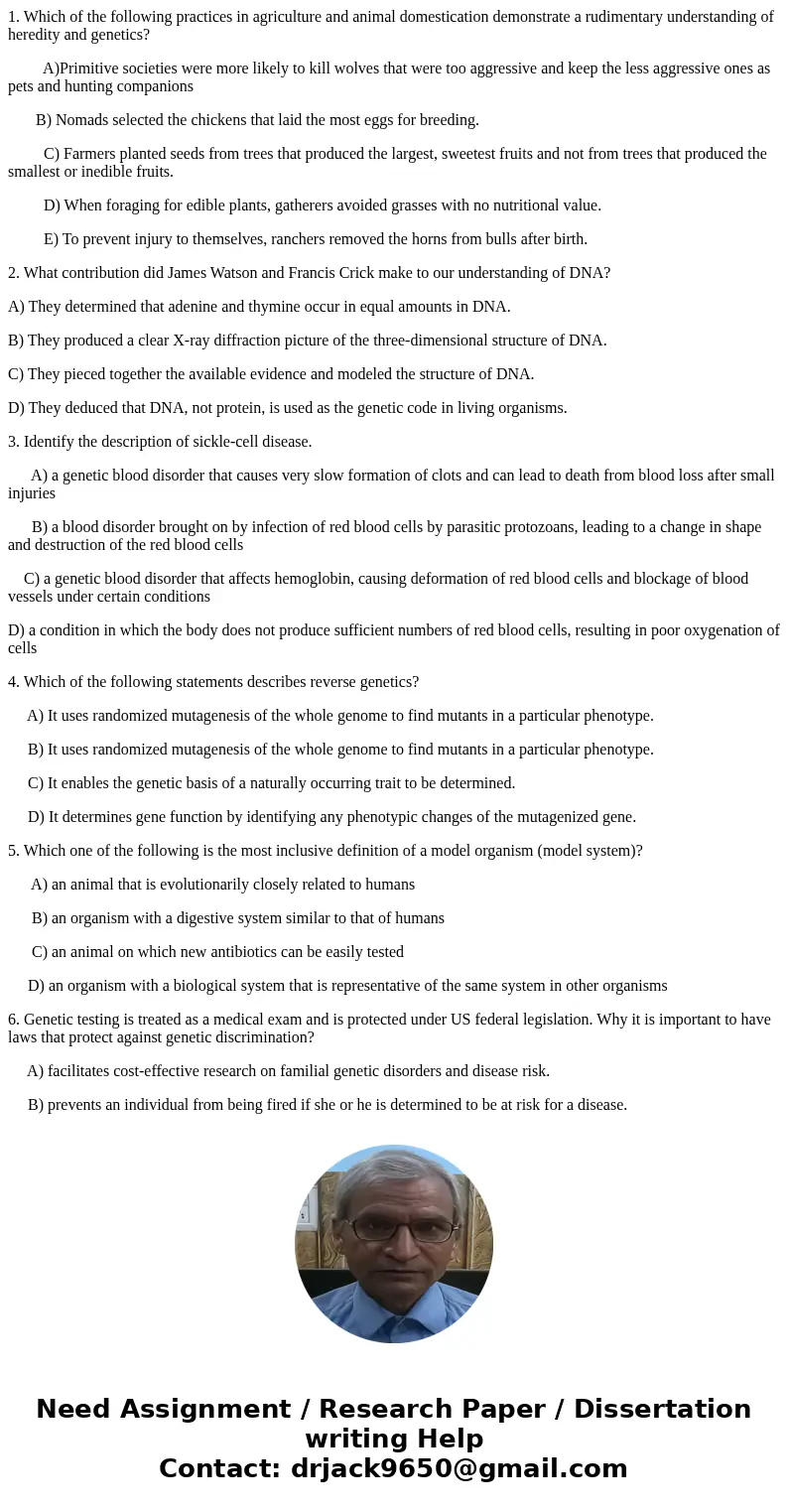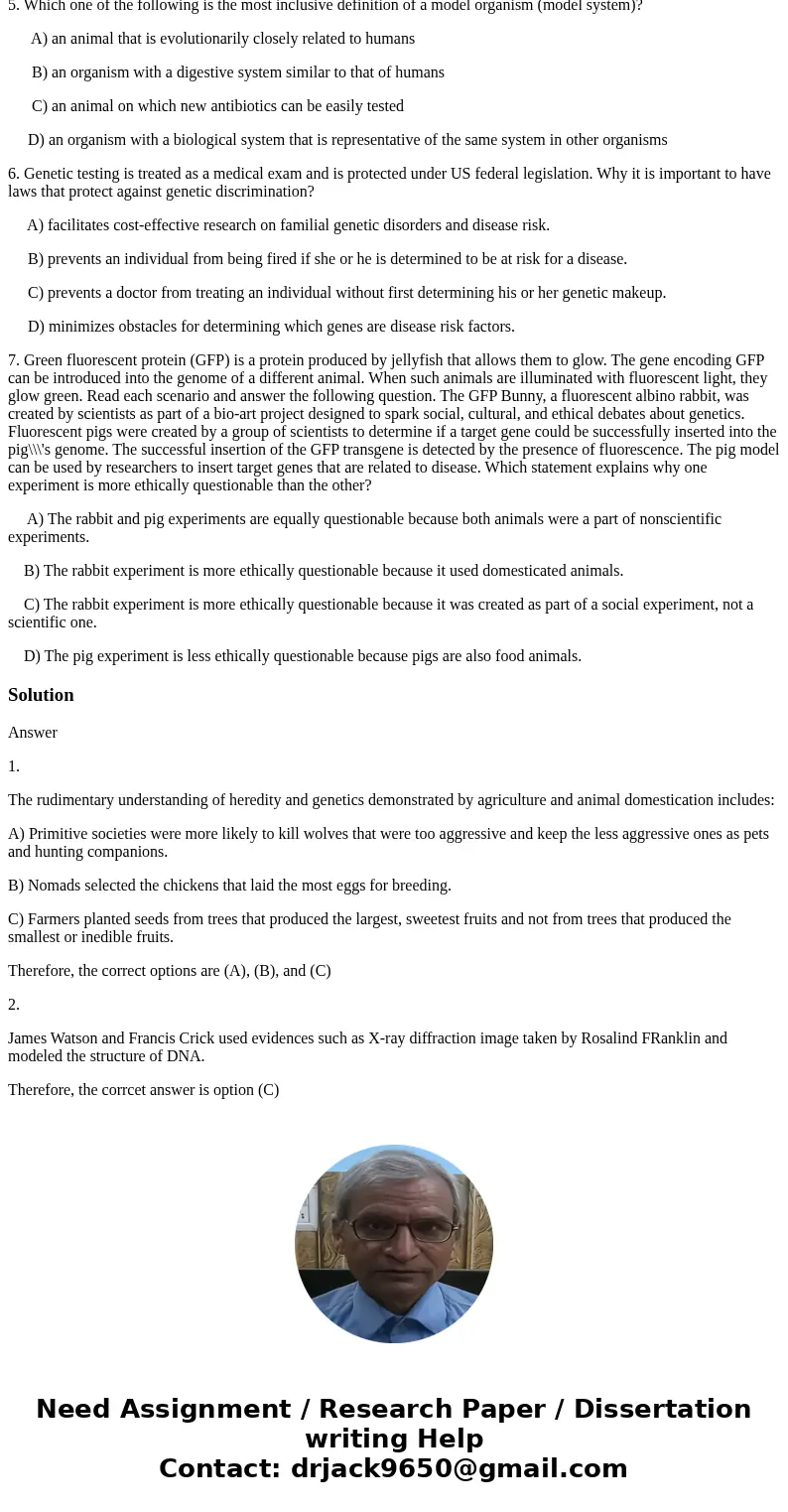1 Which of the following practices in agriculture and animal
1. Which of the following practices in agriculture and animal domestication demonstrate a rudimentary understanding of heredity and genetics?
A)Primitive societies were more likely to kill wolves that were too aggressive and keep the less aggressive ones as pets and hunting companions
B) Nomads selected the chickens that laid the most eggs for breeding.
C) Farmers planted seeds from trees that produced the largest, sweetest fruits and not from trees that produced the smallest or inedible fruits.
D) When foraging for edible plants, gatherers avoided grasses with no nutritional value.
E) To prevent injury to themselves, ranchers removed the horns from bulls after birth.
2. What contribution did James Watson and Francis Crick make to our understanding of DNA?
A) They determined that adenine and thymine occur in equal amounts in DNA.
B) They produced a clear X-ray diffraction picture of the three-dimensional structure of DNA.
C) They pieced together the available evidence and modeled the structure of DNA.
D) They deduced that DNA, not protein, is used as the genetic code in living organisms.
3. Identify the description of sickle-cell disease.
A) a genetic blood disorder that causes very slow formation of clots and can lead to death from blood loss after small injuries
B) a blood disorder brought on by infection of red blood cells by parasitic protozoans, leading to a change in shape and destruction of the red blood cells
C) a genetic blood disorder that affects hemoglobin, causing deformation of red blood cells and blockage of blood vessels under certain conditions
D) a condition in which the body does not produce sufficient numbers of red blood cells, resulting in poor oxygenation of cells
4. Which of the following statements describes reverse genetics?
A) It uses randomized mutagenesis of the whole genome to find mutants in a particular phenotype.
B) It uses randomized mutagenesis of the whole genome to find mutants in a particular phenotype.
C) It enables the genetic basis of a naturally occurring trait to be determined.
D) It determines gene function by identifying any phenotypic changes of the mutagenized gene.
5. Which one of the following is the most inclusive definition of a model organism (model system)?
A) an animal that is evolutionarily closely related to humans
B) an organism with a digestive system similar to that of humans
C) an animal on which new antibiotics can be easily tested
D) an organism with a biological system that is representative of the same system in other organisms
6. Genetic testing is treated as a medical exam and is protected under US federal legislation. Why it is important to have laws that protect against genetic discrimination?
A) facilitates cost-effective research on familial genetic disorders and disease risk.
B) prevents an individual from being fired if she or he is determined to be at risk for a disease.
C) prevents a doctor from treating an individual without first determining his or her genetic makeup.
D) minimizes obstacles for determining which genes are disease risk factors.
7. Green fluorescent protein (GFP) is a protein produced by jellyfish that allows them to glow. The gene encoding GFP can be introduced into the genome of a different animal. When such animals are illuminated with fluorescent light, they glow green. Read each scenario and answer the following question. The GFP Bunny, a fluorescent albino rabbit, was created by scientists as part of a bio-art project designed to spark social, cultural, and ethical debates about genetics. Fluorescent pigs were created by a group of scientists to determine if a target gene could be successfully inserted into the pig\\\'s genome. The successful insertion of the GFP transgene is detected by the presence of fluorescence. The pig model can be used by researchers to insert target genes that are related to disease. Which statement explains why one experiment is more ethically questionable than the other?
A) The rabbit and pig experiments are equally questionable because both animals were a part of nonscientific experiments.
B) The rabbit experiment is more ethically questionable because it used domesticated animals.
C) The rabbit experiment is more ethically questionable because it was created as part of a social experiment, not a scientific one.
D) The pig experiment is less ethically questionable because pigs are also food animals.
Solution
Answer
1.
The rudimentary understanding of heredity and genetics demonstrated by agriculture and animal domestication includes:
A) Primitive societies were more likely to kill wolves that were too aggressive and keep the less aggressive ones as pets and hunting companions.
B) Nomads selected the chickens that laid the most eggs for breeding.
C) Farmers planted seeds from trees that produced the largest, sweetest fruits and not from trees that produced the smallest or inedible fruits.
Therefore, the correct options are (A), (B), and (C)
2.
James Watson and Francis Crick used evidences such as X-ray diffraction image taken by Rosalind FRanklin and modeled the structure of DNA.
Therefore, the corrcet answer is option (C)


 Homework Sourse
Homework Sourse